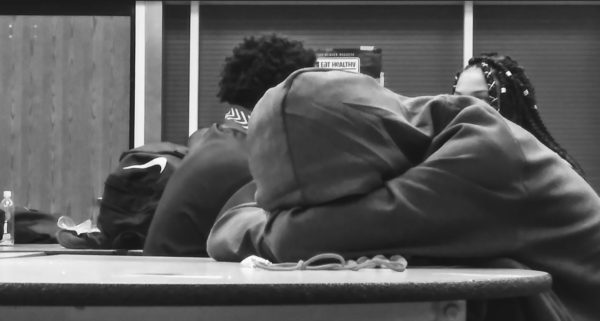Feature Photo By: Alexis Drummond – Student sleeps in the Commons during his off period. Many students take the time during their off period to work on homework, study, or get in a few extra minutes of sleep.
The past 50 years, life has appeared to become simpler, yet there seems to be an increase in mental illnesses. This rise in mental illnesses seems to be found highly in teenagers. Technology has given humans — mainly younger generations — easier access to information and has connected us with so many people across the world.
What has occurred in the last 50 years to trigger the rise in mental illnesses? There is an increase in technology like phones and computers, causing teenagers to stay up later.

It is found that teenagers — between the ages of 13-17– spend on average nine hours a day on their phones. 54% of teenagers say they spend too much time on their phones and 41% say that most of the time they spend on their phones, it is on social media.
“I have a hard time waking up in the morning so I really wish I could sleep in just a bit more,” said sophomore Marissa Chambers. “11:30 is a normal time that I go to bed and I get up at 6:00.”
“In reading studies, it seems like there is a correlation between increased mental health symptoms and smartphone use,” said Katia Duncan, school social worker. “We also know screen time has increased significantly with teens over the past few years. Teens who engage in relatively less screen time and more non-technology based activities (e.g. exercise, reading, attending club meetings, or even doing homework) have been shown to display fewer symptoms of depression and anxiety.”
It may not seem like lack of sleep and the usage of social media can dramatically increase mental health, but over time, the lack of sleep can lead to mood swings and depression. If there is a continuous decline in sleep, then depression increases and leads to other mental illnesses.
“Half of mental health conditions begin by age 14, and 75% of mental health conditions develop by age 24,” Aurora Mental Health Center.
Some of the many mental illnesses that people inherit genetically or develop over time include:
Depression– Depression is a medical illness that negatively affects the way you feel; it affects the way you act and the way you think. Depression causes one to feel sad and/or causes them to lose interest in the things they like to do. Depression affects about one in 15 adults or about 6.7% every year. About one in six or 16.6% of people will feel depressed at some point in their life. Depression is only treated by a medical professional.
Symptoms:
- Feeling Sad
- Loss of interest
- Change in appetite
- Trouble sleeping and/or thinking
- Feeling worthless or guilty
- Thoughts of death or suicide
Bipolar Disorder– Bipolar Disorder is an illness that affects one’s mood, sleep, behavior, thinking, and energy. People with this disorder can feel moments of extreme joy and happiness. Other times they could feel depressed, worthless, or sluggish. Usually, in between the two, they feel normal. Bipolar Disorder is pretty rare and affects only about 2.6% of the U.S. population. There is currently no cure for Bipolar Disorder.
Symptoms:
- Mood swings
- Sadness
- Guilt
- Hopelessness
- Risk-taking behaviors
- Hyperactivity
- Self-harm
- Depression
- Trouble falling asleep
- Paranoia
Obsessive Compulsive Disorder (OCD)– Obsessive Compulsive Disorder is an illness where one has uncontrollable, behaviors (compulsions) and recurring thoughts (obsessions). These behaviors and thoughts are something he/she feels are needed to be repeated. It is said that one in 40 adults in the U.S (2.3%) and one in 100 children (1%) are affected by OCD. There are medications, support groups, and therapies for people who have OCD.
Symptoms:
- Meaningless representation of words
- Social isolation
- Repetitive movements
- Repeatedly going over thoughts
- Panic attacks
- Anxiety
Attention-Deficit/Hyperactivity Disorder (ADHD)- ADHD is a disorder that makes it difficult for one to pay attention, having the need to constantly move or do something, and can cause them to have a lack of control over impulsive behaviors. Symptoms of ADHD are typically noticed, between the ages of 3 and 6. In 2016, approximately 9.4% of children between the ages of 4 and 17 —6.1 million— has been diagnosed with ADHD.

Symptoms:
- Aggression
- Fidgeting
- Hyperactivity
- Absent-mindedness
- Short attention span
- Anger
- Boredom
- Excitement
Autism- Autism is a disorder that impacts the nervous system and impairs one’s communication and interaction. Although Autism can be diagnosed at any age, it is more common for signs to appear in the first two years of one’s life. With 1 in 59 children being diagnosed with autism, boys are more likely to diagnosed than girls. About 1 in 37 boys and 1 in 151 girls are diagnosed.
Symptoms:
- Inappropriate social interaction
- Compulsive behavior
- Learning disability
- Problems paying attention
- Sensitivity to sounds
- Speech delay as a child
Dyslexia- Dyslexia is a disorder that makes reading more complex for those who have it. People who have dyslexia have trouble matching the letters they see with the sounds those letters make. Dyslexia also makes similar looking letters change words in their brain. It is estimated that over 40 million Americans —about 1 in 10— have dyslexia.
Symptoms
- Difficulty memorizing
- Difficulty spelling
- Speech delay or learning disability
- Speech impairment
- Headaches when reading
Insomnia– Insomnia is when someone has problems falling asleep or if they sleep for a long period of time, but they don’t feel well-rested when they do sleep. Insomnia can be related to many other disorders like anxiety, depression, or common things like lack of exercise or poor sleeping patterns. In adults, 30-35% have brief symptoms of insomnia; 15-20% have short-term insomnia (lasts up to three months); 10% have chronic insomnia which occurs at least three times a week for at least three months.
Symptoms:
- Lack of sleep
- Lack of concentration
- Depression
- Headache
Although these aren’t all of the mental illnesses there are in the world, there are still many mental illnesses that affect a variety of different people.
“I think we often lose sight of the fact that mental health is really a spectrum for every individual that can change through stages of their lives and even day to day,” said Duncan.
If you, a family member, or a friend show signs of developing any of these or other illnesses, don’t hesitate to contact somebody. You can contact Aurora Mental Health, Safe2Tell, or a trusted adult.


















